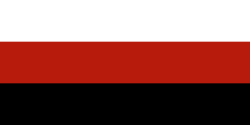 | |
| Proportion | 2:3 |
|---|---|
| Adopted | 20 May 2008 |
| Design | A horizontal tricolor of red, white and blue with an eight-pointed red cross. |
| Designed by | Andrey Alyoshkin |
 Flag of Mordovia (1995–2008) | |
| Proportion | 1:2 |
| Adopted | 30 March 1995 |
| Design | A horizontal tricolor of red, white and blue with an eight-pointed red cross. |
 Flag of Mordovia (1990–1995) | |
| Proportion | 1:2 |
| Adopted | 7 December 1990 |
| Design | A variant of the Russian SFSR flag with "Mordovian SSR" written in the Russian, Erzyan, and Mokshan languages respectively. |
The flag of the Republic of Mordovia in Russia [a] is a horizontal tricolour of red, white and blue. It is charged with a brown-red sun emblem in the center of the white strip. The emblem is divided into four parts, symbolizing the four Mordvin tribes. Its proportions are 1:2:1.
Contents
The flag was adopted on 20 May 2008. The proportions are 2:3.









